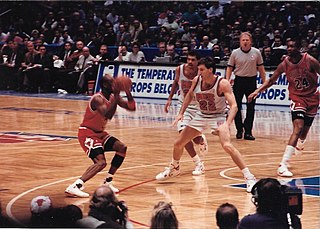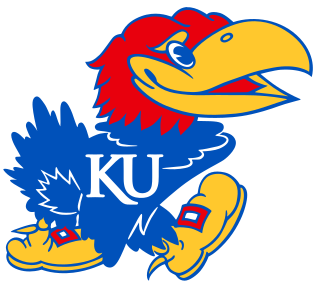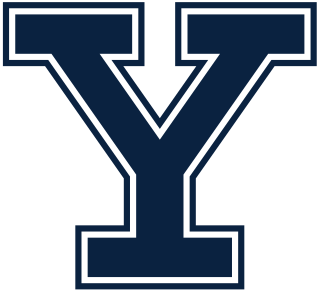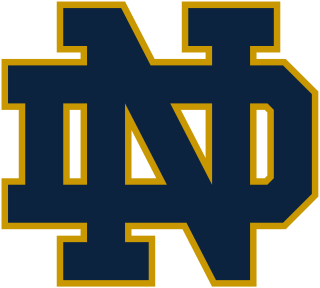Related Research Articles

Basketball is a team sport in which two teams, most commonly of five players each, opposing one another on a rectangular court, compete with the primary objective of shooting a basketball through the defender's hoop, while preventing the opposing team from shooting through their own hoop. A field goal is worth two points, unless made from behind the three-point line, when it is worth three. After a foul, timed play stops and the player fouled or designated to shoot a technical foul is given one, two or three one-point free throws. The team with the most points at the end of the game wins, but if regulation play expires with the score tied, an additional period of play (overtime) is mandated.

College football is gridiron football that is played by teams of amateur student-athletes at universities and colleges. It was through collegiate competition that gridiron football first gained popularity in the United States.

The Big Ten Conference is the oldest Division I collegiate athletic conference in the United States. Founded as the Intercollegiate Conference of Faculty Representatives in 1896, it predates the founding of its regulating organization, the NCAA. It is based in the Chicago area in Rosemont, Illinois. For many decades the conference consisted of 10 prominent universities, which accounts for its name. As of 2014, it consists of 14 member institutions and 2 affiliate institutions, with 4 new member institutions scheduled to join in 2024. The conference competes in the NCAA Division I and its football teams compete in the Football Bowl Subdivision (FBS), formerly known as Division I-A, the highest level of NCAA competition in that sport.

James Naismith was a Canadian-American physical educator, physician, Christian chaplain, and sports coach, best known as the inventor of the game of basketball. After moving to the United States, he wrote the original basketball rule book and founded the University of Kansas basketball program in 1898. Naismith lived to see basketball adopted as an Olympic demonstration sport in 1904 and as an official event at the 1936 Summer Olympics in Berlin, as well as the birth of the National Invitation Tournament (1938) and the NCAA Tournament (1939).

Women's basketball is the team sport of basketball played by women. It was first played in 1892, one year after men's basketball, at Smith College in Massachusetts. It spread across the United States, in large parts via women's college competitions, and has since spread globally. As of 2020, basketball is one of the most popular and fastest growing sports in the world.

In United States colleges and universities, basketball is governed by collegiate athletic bodies including the National Collegiate Athletic Association (NCAA), the National Association of Intercollegiate Athletics (NAIA), the United States Collegiate Athletic Association (USCAA), the National Junior College Athletic Association (NJCAA), and the National Christian College Athletic Association (NCCAA). Each of these various organizations is subdivided into one to three divisions, based on the number and level of scholarships that may be provided to the athletes. Teams with more talent tend to win over teams with less talent.

A shot clock is a countdown timer used in a variety of games and sports, indicating a set amount of time that a team may possess the object of play before attempting to score a goal. Shot clocks are used in several sports including basketball, water polo, canoe polo, lacrosse, poker, ringette, korfball, tennis, ten-pin bowling, and various cue sports. It is analogous with the play clock used in American and Canadian football, and the pitch clock used in baseball. This article deals chiefly with the shot clock used in basketball.

Spencer Haywood is an American former professional basketball player and Olympic gold medalist. Haywood is a member of the Naismith Memorial Basketball Hall of Fame, being inducted in 2015.

College athletics in the United States or college sports in the United States refers primarily to sports and athletic training and competition organized and funded by institutions of tertiary education in a two-tiered system.

The Kansas State Wildcats are the intercollegiate athletic teams that represent Kansas State University. The official color of the teams is Royal Purple; white and silver are generally used as complementary colors.

The Kansas Jayhawks men's basketball program is the intercollegiate men's basketball program of the University of Kansas. The program is classified in the NCAA's Division I and the team competes in the Big 12 Conference. Kansas is considered one of the most prestigious college basketball programs in the country with six overall national championships, as well being runner-up six times and having the most conference titles in the nation. The Jayhawks also own the NCAA record for most consecutive NCAA Tournament appearances with 28 consecutive appearances. Since the 1984 tournament, the Jayhawks have only missed the tournament twice and both times were due to disciplinary action from the NCAA; they were ruled ineligible for the 1989 tournament and had their 2018 appearance was vacated. They have not missed the tournament strictly due to on the court performance since the 1983 tournament. They were also, along with Dartmouth, the first team to appear in multiple NCAA Tournaments after making their second appearance in the 1942 tournament. The Jayhawks had been ranked in the AP poll for 231 consecutive polls, a streak that had stretched from the poll released on February 2, 2009, poll through the poll released on February 8, 2021, which is the longest streak in AP poll history. Of the 24 seasons the Big 12 conference has been in existence, Kansas has won at least a share of 19 regular-season conference titles.

The Yale Bulldogs are the intercollegiate athletic teams that represent Yale University, located in New Haven, Connecticut. The school sponsors 35 varsity sports. The school has won two NCAA national championships in women's fencing, four in men's swimming and diving, 21 in men's golf, one in men's hockey, one in men's lacrosse, and 16 in sailing.
The Syracuse Orange men's basketball program is an intercollegiate men's basketball team representing Syracuse University in Syracuse, New York. The program is classified in the NCAA Division I of the National Collegiate Athletic Association (NCAA), and the team competes in the Atlantic Coast Conference (ACC).

Basketball began with its invention in 1891 in Springfield, Massachusetts, by Canadian physical education instructor James Naismith as a less injury-prone sport than football. Naismith was a 31-year-old graduate student when he created the indoor sport to keep athletes indoors during the winters. The game became established fairly quickly and grew very popular as the 20th century progressed, first in America and then in other parts of the world. After basketball became established in American colleges, the professional game followed. The American National Basketball Association (NBA), established in 1946, grew to a multibillion-dollar enterprise by the end of the century, and basketball became an integral part of American culture.
The Davidson Wildcats football program is the intercollegiate American football team for Davidson College located in the U.S. state of North Carolina. The team competes in the NCAA Division I Football Championship Subdivision (FCS) and are members of the Pioneer Football League. Davidson's first football team was fielded in 1896. The team plays its home games at the 4,741 seat Richardson Stadium in Davidson, North Carolina. The Wildcats are coached by Scott Abell.

The Wabash Little Giants are the intercollegiate athletics teams that represent Wabash College, a small private school for men in Crawfordsville, Indiana, United States. The college belongs to the National Collegiate Athletic Association and participates in Division III sports. The Little Giants compete as members of the North Coast Athletic Conference (NCAC). Despite the college's small enrollment and that it is "not a jock school", the Little Giants have had success in several sports. The most popular among Wabash fans are football and swimming. The Little Giants also have a well-respected cross-country team. In football, Wabash has an important rivalry with DePauw University, and each season they meet for the Monon Bell Classic. Wabash and DePauw compete annually to win the trophy, the Monon Bell, and as of 2015 the two teams have played 122 games in the series with Wabash holding a 60-53-9 advantage.
The Indiana Intercollegiate Athletic Association was an American college athletic conference established in 1890 by institutions in the state of Indiana. At a time when the National Collegiate Athletics Association (NCAA) did not yet exist, such organizations attempted to bring order out of the chaos of the formative years of American intercollegiate sports.

The 1933–34 Georgetown Hoyas men's basketball team represented Georgetown University during the 1933–34 NCAA college basketball season. Fred Mesmer coached it in his third season as head coach. The team was a member of the Eastern Intercollegiate Conference (EIC) and played its home games at Tech Gymnasium on the campus of McKinley Technical High School in Washington, D.C. The team was the first of two winning teams during Mesmer's seven-season tenure, finishing with a record of 12-11 overall, 5-5 in the EIC.

The Notre Dame Fighting Irish men's basketball statistical leaders are individual statistical leaders of the Notre Dame Fighting Irish men's basketball program in various categories, including points, three-pointers, assists, blocks, rebounds, and steals. Within those areas, the lists identify single-game, single-season, and career leaders. The Fighting Irish represent the University of Notre Dame in the NCAA's Atlantic Coast Conference.
The Gonzaga Bulldogs men's basketball statistical leaders are individual statistical leaders of the Gonzaga Bulldogs men's basketball program in various categories, including points, three-pointers, rebounds, assists, steals, and blocks. Within those areas, the lists identify single-game, single-season, and career leaders. The Bulldogs represent Gonzaga University in the NCAA Division I West Coast Conference.
References
- 1 2 ESPN College Basketball Encyclopedia. ESPN. 2009. pp. 528–529. ISBN 978-0-345-51392-2.
- ↑ Official Basket Ball Rules. A. G. Spalding & Bros. 1897–1898. p. 9.